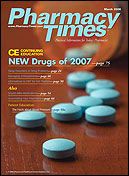Publication
Article
Pharmacy Times
DIABETES WATCH
ThermometersMay Save Limbs
A special thermometer that measures the soles of diabetics'feet may help prevent foot ulcers, which can lead toamputations if not caught early.
A study of 225 veterans with diabetes found that using thethermometer reduced, by nearly two thirds, the number ofhigh-risk patients who developed foot ulcers. The study is thethird in a series of government-funded research. With thethermometer, patients measure a certain number of spots oneach foot. Once the thermometer signals a hot spot, patientsget off their feet for about a day or until the temperature normalizes.Taking pressure off prior to the skin cracking allowsthe body to heal more easily, compared with a full wound.
Can Obesity SurgeryCure Diabetes?
Weight-loss surgery was more effective as a treatment fortype 2 diabetes, according to a new study of 60 patients.
The study found that 73% of patients who had adjustablegastric banding surgery had total remission of their diabetes,compared with 13% of those given conventional treatment.
Researchers noted that the results do not apply to allpatients with type 2 diabetes. The participants had fairly mildcases and received the diagnosis within the previous 2 years.For patients with more severe and more years with diabetes,the disease may not be reversible. The findings were reportedin the January 23, 2008, issue of the Journal of theAmerican Medical Association.
Diabetes Costs Skyrocket
The uncontrolled diabetes epidemic is taking a heavyfinancial toll?$174 billion a year, according to the January23, 2008, study released by the American DiabetesAssociation (ADA). The price tag is as much as the wars inIraq, Afghanistan, and the global war on terrorism combined.It costs $24 billion more than the damages caused byHurricane Katrina.
The financial burden also falls on individuals without thedisease through rising health insurance premiums andcopays, stated Paul Fronstin of the Employee BenefitResearch Institute, who was not involved with the report.The study showed that about half of the patients with diabeteshave medical insurance through government programs.Routine care for patients with diabetes cost relativelylittle. The real cost comes from uncontrolled diabetes,said Ann Albright, PhD, RD, president of health care and educationat the ADA, which funded the study.
Dr. Albright anticipates the number of patients diagnosedwith diabetes to rise, taking into account that manyAmericans have prediabetes, with trouble handling insulinand sugar. For more information on the report, visitwww.diabetes.org.
Diabetes Linked to Blood Vessel Inflammation
A study, reported in the November20, 2007, online issue of the Journal ofClinical Endocrinology & Metabolism,found a new pathway that increases adangerous inflammation of blood vesselsin patients with diabetes. The researchersbelieve that good control ofthe disease may reduce this inflammationand possibly lower the risk of heartdisease.
The investigators found that patientswith type 1 diabetes have increased expressionand signaling of 2 main receptorswithin the innate immune system.These Toll-like receptors, known as TLR2and TLR4, are part of a family of pattern-recognitionreceptors. The investigatorsconcluded that an increased expressionof TLR2 and TLR4 in patients with type 1diabetes adds to blood-vessel inflammation.
Sleep Disruption Ups Diabetes Risk
Interrupting sleep damages the body's ability to regulateblood-sugar levels and increases the odds of type 2 diabetes,especially in young adults. The current study, reported in theDecember 31, 2007, issue of the Proceedings of the NationalAcademy of Sciences, provides the first evidence linking poorsleep quality to an increased diabetes risk. Nine lean, healthyindividuals (between the ages of 20 and 31) were observedfor 2 nights of uninterrupted sleep to establish their normalsleep patterns, then for a 3-night study period, during whichthe researchers purposely disturbed their sleep when theirbrain waves showed the beginning of slow-wave sleep.
At the study's conclusion, the researchers administeredintravenous glucose to each participant and took blood samplesevery few minutes to measure the levels of glucose andinsulin. They found that the participants were 25% less sensitiveto insulin following nights of interrupted sleep.
F A S T F A C T : Foot ulcers strike 600,000 patients with diabetes in the United States each year.







